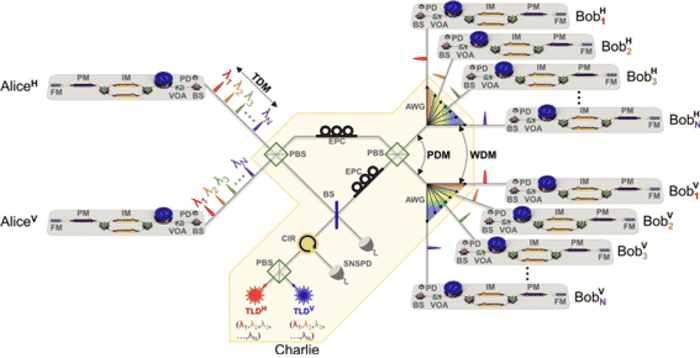Modern public-key cryptosystems may have recently been vulnerable to security flaws against powerful quantum computers. Quantum cryptosystems have drawn a lot of attention as a potential solution.
Quantum cryptosystems use quantum keys that guarantee security based on quantum physics rather than computational complexity. Hence, they are believed to be more secure.
The essential technique for implementing quantum cryptosystems is quantum key distribution (QKD). To commercialize QKD, two key technological difficulties must be resolved. One is the communication distance, and the other is the expansion from one-to-one (1:1) communication to one-to-many (1:N) or many-to-many (N: N) network communication.
The research team at the Korea Institute of Science and Technology (KIST, Director Seok-jin Yoon) has successfully demonstrated a practical TF QKD network. This is the second experimental demonstration of the TF QKD network in the world after the University of Toronto in Canada.

CREDIT
Korea Institute of Science and Technology
The research team proposed a new TF QKD network structure scalable to a two-to-many (2:N) network based on polarization-, time-, and wavelength-division multiplexing. Unlike the first demonstration of the University of Toronto based on a ring network structure, the research team’s architecture is based on a star network. The quantum signal in a ring structure must pass through every user connected to the ring; however, the star structure only has it through the center, making it possible to implement a more practical QKD system.
The team applied a plug-and-play (PnP) structure to this TF QKD system. Unlike conventional TF QKD system, which uses many control systems to maintain the indistinguishability of two quantum signals emitted by two users’ different light sources, this new PnP TF QKD architecture requires the middle third-party to generate and transmit the initial signals to both users using a single light source, and the signals return to the third-party by making a round trip.
As a result, users have essentially the same wavelength, and the channel’s birefringence effect automatically compensates for any polarisation drift. Additionally, since the two signals follow the same path but in different directions, their arrival timings are invariably the same. The architecture developed by the research team can therefore be implemented using just a phase controller. The researchers completed an experimental demonstration of a TF QKD network based on the architecture.
Sang-Wook Han, the leader of the Center for Quantum Information, said, “It is a significant research achievement showing the possibility of solving the two main obstacles to QKD commercialization, and we have gained a key technology leading the corresponding research.”
Journal Reference:
- Park, C.H., Woo, M.K., Park, B.K. et al. 2×N twin-field quantum key distribution network configuration based on polarization, wavelength, and time division multiplexing. npj Quantum Inf 8, 48 (2022). DOI: 10.1038/s41534-022-00558-8


